Contrary to the rising number of educational institutions and enrolment of students, the funds allocated to the education sector in India has seen a clear dip in the last five years. The current fund allotted to the education sector is 3.5 per cent of the Union Budget in 2019-20, compared to 4.6 per cent in 2014-15.
The constant decline in the percentage share of funds allocation to the education sector is evident from the figures given in the report published by the Centre for Budget and Governance Accountability (CBGA) India. These funds began shrinking in the year 2015-16 (3.9%), remained 3.7 per cent from 2016 to 2018, and came down to 3.6 per cent of the total Union Budget in 2018-19.
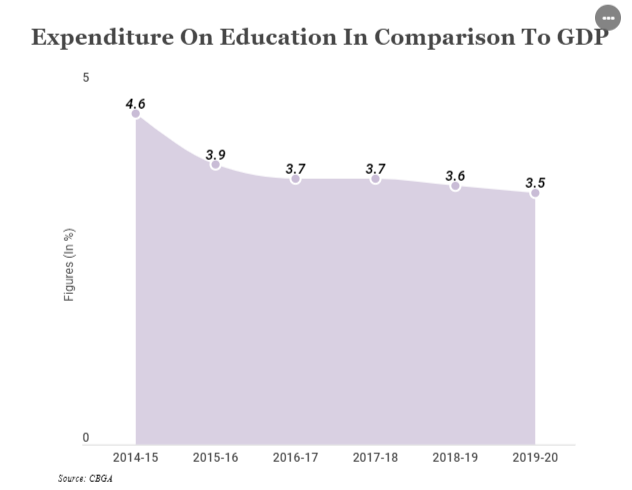
As opposed to funds, the number of recognised institutions across the country, however, has consistently risen in the last five years. The data also shows that the number of colleges in the year 2017-18 was 39,050, while in the year 2013-14 it was 36,634. This change accounted for 6.59 per cent increase. The number of colleges was 40,026 in the previous year, which reduced by 976 as a result of the deletion of unregistered colleges from the government list.
This was one positive move taken by the government which helped retain the faith in the other legal institutions.
According to All India Survey on Higher Education (AISHE) report, the deletion takes place annually. All institutions of higher education are requested to register and furnish concerning information to the government. Those who don’t furnish the details or fail to do so as per the prescribed standards are deregistered after the review.
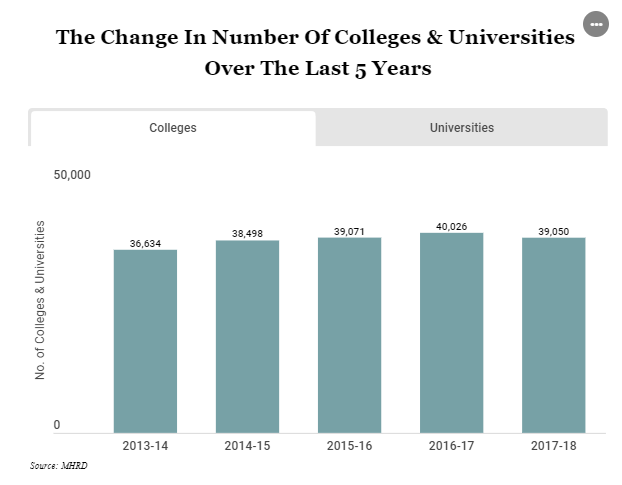
The enrolment for higher education has also seen a clear increase over the past five years. It was 3.23 crore in 2013-14 and it increased to 3.66 crore in 2017-18. The per cent hike was recorded to be 13.29 percentage points during the above mentioned time.
However, according to professor R Govinda, a former vice chancellor, National University of Educational Planning, people should not to be enamoured by the rate of expansion. This rate of expansion, Govinda says, is the “actual problem.”
“Most colleges that have expanded are the private self-financing ones. These are all affiliated colleges that are suffering from poor quality,” said Govinda, adding, “This expansion means there is neither equity nor quality.”
Govinda said while the government has taken care of the elite institutes, there is no clarity on the fate of others. In his opinion, the government has only opened more IITs (Indian Institutes of Technology) and IIMs (Indian Institute of Management), which will not solve the problem of higher education as a large number of students go for the self-financing colleges only.
On the other hand, the number of state universities has also increased from 462 in 2013-14 to 613 in 2017-18 -- which is a whopping 32.6 per cent hike. However, only three central universities were added to the list, making it 45 in the last year.
The institutes of National reached crossed the 101 in 2017-18, an increase of 33 from 68 in 2013-14.
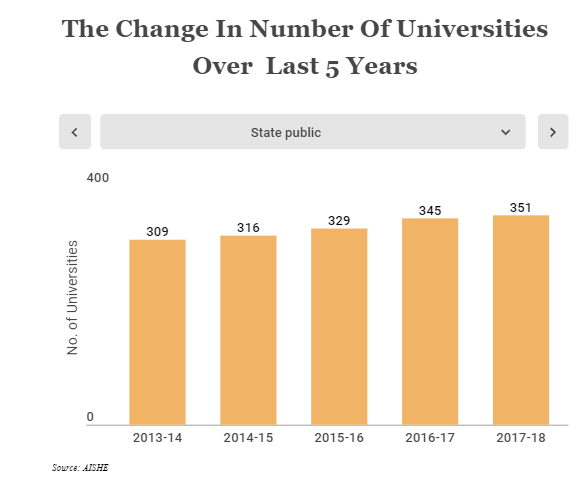
Contrary to common perception, country’s IITs and IIMs got more than two-fold of the funds in 2017-18 as compared to their allocation in 2014-15. The allocation for the year 2017-18 was 8,337 (IITs) and 821 (IIMs) crore by the central government.
However, there’s caveat.
A source from one of the IITs said the funds for premium institutes show a spike because of the Higher Education Financing Agency (HEFA) loans. HEFA is a collaborative initiative by the ministry of human resource development and Canara Bank, which lent loans at zero per cent interest rate to these organisations.
“Things are better loan-wise but there is nothing remarkable in grants. The small raise must be because of the expansions in IITs. That’s why the number has increased. The older IITs are recruiting more people and students so that the budget sees an increase,” the source said.
News18 further learnt that there was a decline in infrastructure funds during the BJP rule in these IITs, which was managed by the non-recurring part of the IIT budget. But now that has been taken care of by way of HEFA loans. This points to the fact that in real terms there is no enhancement in funds.
The other area of interest where BJP cut down the funds was the University Grants Commission (UGC). The UGC funds were cut down by almost half or 47.39 per cent. Surprisingly, these were cut by 4,221 crore in the last five years; the funds allocated to UGC came down to 4,685 crore in 2017-18 from 8,906 crore in 2014-15.
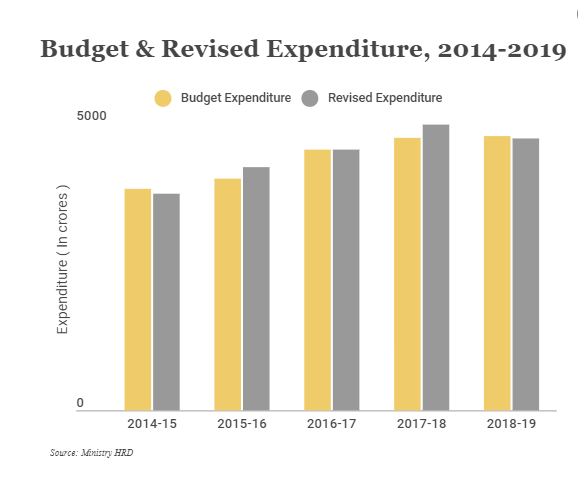
The new BJP Manifesto—Sankalpit Bharat Sashakt Bharat—has also focused on expansion and setting up of new learning centres. These institutes will also work on incorporating more students as per the new law. This year the government announced that people belonging to EWS, who are not covered under the scheme of reservation for SCs, STs and OBCs, shall get 10% reservation in direct recruitment in civil posts and services in the Government of India.
However, school education is one area where the BJP has done exponentially well. If we see the data of the past five years, we find that schools have witnessed a quantitative increase. But the most notable exception is the number of primary schools that have dipped by 1.56 per cent
Explaining this trend, former HRD official explained that the government had found some schools without sufficient infrastructure and it resulted in the closure of these schools.
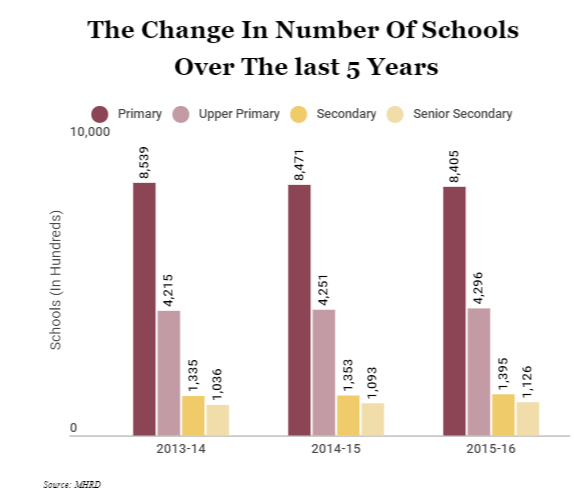
The number of primary schools in 2013-2014 was 8,539. It reduced to 8,405 in 2015-16 as per the statistical report by the ministry of human resources development. The number of upper primary schools has increased from 4,215 in 2013-14 to 4,296 in 2015-16, which accounts for 1.92% per cent hike
The number of secondary and senior secondary schools also witnessed an increase of 4.49 and 7.90 per cent respectively. In the year 2013-14, there were a total of 1,335 and 1,036 secondary and senior secondary schools respectively. The number rose to 1,395 and 1,126 in 2015-16, revealed the report.
Schemes such as the Mid-Day meal saw an inconsistent pattern with an increase to Rs 10,000 crore (2017-18) from Rs 9,700 in 2016-2017. These schemes, namely Sarva Shiksha Abhiyan and Sakshar Bharat, have seen a continuous decline in funds. For Sakshar Bharat, funds came down to 244 crore in 2016-17 from 371 crore in 2013-14. Contrary to the decline in funds allocation, the total number of beneficiaries under the Saakshar Bharat scheme increased to 1.9 crore from 1 crore between 2014-15 and 2016-17.
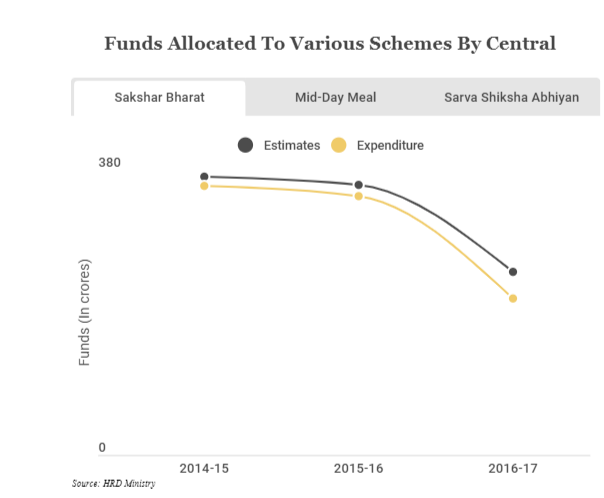
The expense on Mid-Day meal scheme went down to 10,000 crore in 2015-16 from 13,215 crore in 2013-14 during the BJP regime. The funds of Sarva Shiksha Abhiyan were cut down by 7.71 per cent (1,880 crore), which made it 22,500 crore a year in 2017-18.
In the 2018-19 Union Budget, the Centre also introduced the Samagra Shiksha Abhiyan to smoothen the funds flow in the education sector. This scheme considers schooling from pre-schools till class 12. The data for the same has not been made available.
The central governments, however, have readily taken care of the flagship school—Kendriya Vidyalayas and Navodaya Vidyalayas—in the Union Budget.
The funding of the Navodaya Vidyalayas—a vital institution imparting better quality education in rural areas—has increased by a striking 58.12 per cent. It’s budget in the year 2014-15 was 2,013 crore, which propelled to 3,185 crore in 2017-18. Even the urban-centric Kendriya Vidyalayas (KV) have been given due weight as far as funds are concerned. The KVs gained 35.1 per cent hike in funds. The allotted budget was 3,243 crore in 2014-15 and it got a boost later to reach to 4,997 crore in total.

The enrolment in the schools, however, remains on a constant decline, while that of colleges and universities grew during the BJP rule
The total enrolment to primary schools was 13.24 crore in 2013-14, which reduced to 12.91 crore in 2015-16. The dip was 2.49 per cent. The picture remained the same even when gender perspective was taken into account. It recorded 1.4 and 2.5 per cent dip in the enrolment of boys and girls respectively.
The picture does not look satisfactory even when looked at from a qualitative perspective. As per the ASER (Annual Status of Education Report) findings, only 27.2 per cent students of class 3 were able to read the text, while a mere 28.1 per cent could do the basic arithmetic calculation such as subtraction. Only 44 per cent class 5 students could pass the overall arithmetic test consisting of basic arithmetic operations.
The pupil-teacher ratio in school-level education witnessed progress till 2015-16. The ratio remained as one teacher for 25 students in primary schools, while it was 26 in secondary schools in 2013-14. In the year 2015-16, it changed to 23 and 27 for primary and secondary schools, respectively. In higher education, the figure has been more or less stable at 24 for years.


 26th April 2019
26th April 2019